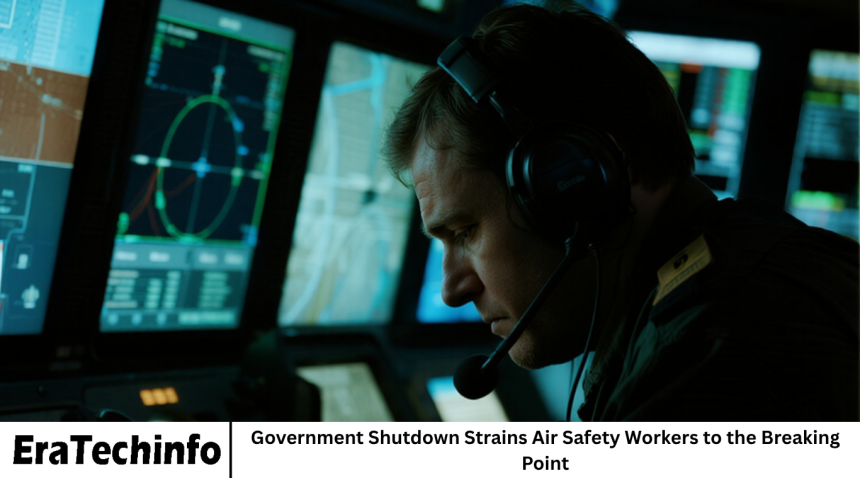The ongoing government shutdown has once again exposed the cracks in the nation’s critical infrastructure—particularly within the aviation industry. As federal agencies remain partially closed and thousands of workers go unpaid, the people who keep the skies safe are facing unbearable pressure. Air traffic controllers, safety inspectors, and maintenance crews are working without pay, struggling to maintain safety standards under increasingly stressful conditions.
The shutdown’s impact reaches far beyond delayed paychecks. It threatens the safety of travelers, disrupts essential operations, and strains the mental health of the dedicated professionals responsible for ensuring that flights take off and land safely every day. This crisis has become a stark reminder of how deeply government stability is tied to public safety.
How the Shutdown Affects Air Safety
When a government shutdown occurs, many federal agencies halt or reduce their operations. In aviation, this affects the Federal Aviation Administration (FAA), which oversees air traffic control, safety inspections, and certifications. Although air travel continues during a shutdown, many employees in essential roles must work without pay.
Air traffic controllers and aviation safety inspectors are among those classified as “essential personnel.” They must continue working to prevent flight delays, mid-air incidents, and accidents. However, unpaid labor creates enormous stress and fatigue, which can directly affect performance and decision-making.
The FAA also slows or stops training programs, certification processes, and non-emergency maintenance checks during a shutdown. This means fewer safety inspections, delayed upgrades to aging systems, and less oversight of airline operations.
The Human Cost of the Shutdown
Behind the statistics and flight schedules are real people—highly trained professionals responsible for millions of lives every day. During a shutdown, many of them face financial strain, emotional exhaustion, and growing anxiety.
Air traffic controllers, for instance, work long hours under immense pressure. They must remain alert at all times to ensure aircraft separation and safety. When paychecks stop, stress increases dramatically. Many workers struggle to pay rent, buy groceries, or cover childcare expenses.
Union leaders and aviation experts have warned that these conditions are unsustainable. Without financial security, the workforce’s morale and focus decline. The situation creates a dangerous mix of fatigue, distraction, and frustration—all of which can undermine safety.
A Growing Risk to Flight Safety
Experts warn that prolonged shutdowns can have cumulative effects on flight safety. Even though planes are still flying, the system’s reliability weakens with each passing day.
During normal operations, the FAA conducts regular inspections, system tests, and updates. These preventive actions are crucial to catching problems before they become emergencies. But during a shutdown, much of this work stops. Inspectors cannot access certain facilities, maintenance checks get postponed, and non-critical repairs are delayed.
Over time, these disruptions add up. The longer the shutdown lasts, the greater the risk that small problems could escalate into larger ones. Aviation is an industry built on precision and constant oversight; any break in that chain introduces risk.
Economic Impact on the Aviation Industry
The shutdown does not only harm workers—it also costs the economy billions of dollars. Every day of closure adds pressure to airlines, airports, and related businesses. Delays in certification slow down new aircraft deliveries, pilot training programs, and infrastructure upgrades.
Airports depend on smooth coordination with federal agencies for security checks, flight planning, and regulatory approvals. When these systems slow down, airlines face longer turnaround times and reduced efficiency. Some smaller airports even have to cancel or reschedule flights due to staffing shortages.
Travelers also feel the impact. Delayed flights, canceled routes, and slower security processing contribute to frustration and lost business. Tourism, which relies heavily on air travel, suffers significantly during extended shutdowns.
Mental Health and Worker Fatigue
The stress caused by working without pay cannot be overstated. Aviation professionals must maintain high levels of concentration, accuracy, and calm under pressure. Yet, financial uncertainty and long working hours erode their mental well-being.
Reports from previous shutdowns revealed rising rates of depression, anxiety, and burnout among federal aviation workers. Many reported being unable to focus properly on their duties, which increases the risk of mistakes.
Unions and mental health experts have urged government leaders to recognize the human cost of shutdowns. They argue that expecting people to perform critical safety roles under financial distress is both unfair and unsafe.
The Role of the FAA and Air Traffic Controllers
The FAA and air traffic controllers form the backbone of the aviation safety network. Without their constant supervision, coordination, and quick decision-making, air travel would not be possible.
Air traffic controllers guide thousands of planes daily through complex airspaces, ensuring each aircraft maintains safe distances from others. They rely on advanced radar, communication systems, and split-second judgment. Even minor distractions can have major consequences.
When these professionals are forced to work unpaid, fatigue and low morale take a toll. The National Air Traffic Controllers Association (NATCA) has repeatedly warned that the safety margin in the air traffic system becomes thinner with each day of a shutdown.
Safety Inspectors and Maintenance Delays
While air traffic controllers handle flight coordination, aviation safety inspectors ensure that aircraft are airworthy. Their inspections cover everything from engine performance to emergency procedures.
During a shutdown, many of these inspections are delayed. New aircraft certifications, safety audits, and maintenance checks are postponed, creating backlogs that can take months to clear. This delay not only affects airlines but also passengers who depend on safe and reliable travel.
These inspections are not just formalities—they are essential layers of protection. Missing or delaying them could allow unnoticed mechanical issues to persist, increasing long-term risks.
How Unions and Workers Are Responding
Unions representing aviation workers have been vocal in their criticism of the shutdown’s effects. NATCA, the Professional Aviation Safety Specialists (PASS), and other groups have issued warnings to lawmakers about the dangers of continued funding lapses.
Many unions have organized rallies, filed legal actions, and appealed directly to Congress to end shutdowns affecting safety personnel. Their message is clear: air safety should never be compromised for political disputes.
Some workers have shared personal stories on social media about the emotional toll of working without pay. Their testimonies highlight the real-world consequences of government inaction—showing that behind every delayed paycheck is a person trying to keep others safe while struggling to stay afloat.
The Political Stalemate Behind the Shutdown
Government shutdowns usually result from political gridlock over budgets and funding bills. When lawmakers fail to agree on government spending, federal agencies lose the authority to pay their workers and operate normally.
In this case, the dispute over funding priorities and political disagreements has once again left federal employees caught in the crossfire. Both parties blame each other, but workers and the public bear the real burden.
For aviation professionals, the situation feels especially unfair. They are expected to keep the skies safe while their own livelihoods hang in uncertainty. Many have called for legislative reforms to protect essential workers from the effects of future shutdowns.
Possible Long-Term Consequences
Even after a shutdown ends, its effects linger. The aviation system takes time to recover from disrupted schedules, backlogged inspections, and delayed training programs. Worker morale also takes time to rebuild, and some employees may leave public service altogether.
This loss of skilled professionals could create future staffing shortages, especially in specialized roles like air traffic control and aircraft certification. Training replacements takes years, meaning shutdowns can have consequences that extend far beyond their official end.
In the long run, repeated shutdowns weaken trust in the system and make it harder to attract and retain top talent in aviation safety roles.
Lessons from Previous Shutdowns
The United States has experienced multiple government shutdowns over the years, each revealing vulnerabilities in the aviation system. During the 2018–2019 shutdown, reports surfaced of air traffic delays, stressed workers, and growing safety concerns.
At that time, the Air Traffic Controllers Association warned that staffing levels were at their lowest in decades. Workers were stretched thin, and the system was “at the breaking point.” The current shutdown echoes many of those same warnings, proving that lessons from the past remain unheeded.
Industry experts have urged policymakers to create permanent funding protections for critical safety sectors. Ensuring that aviation personnel are paid regardless of political disputes could prevent similar crises in the future.
Public Confidence in Air Travel
Passengers may not see the internal struggles of aviation workers, but the impact is real. Delays, longer lines, and disrupted schedules erode public confidence in the safety and reliability of air travel.
When passengers hear that inspectors are furloughed or working unpaid, they naturally question whether flying is as safe as it should be. While major incidents remain rare, maintaining public trust requires transparency and reassurance.
Government leaders and aviation agencies must communicate clearly about what is being done to maintain safety during shutdowns. Otherwise, fear and misinformation can spread faster than facts.
What Can Be Done to Prevent Future Crises
Experts and labor unions have proposed several measures to prevent similar crises. One idea is to classify aviation safety workers as “permanently funded,” ensuring they receive pay even during political deadlocks. Another proposal calls for creating an emergency aviation fund to cover operational costs during shutdowns.
Lawmakers could also pass legislation requiring Congress to maintain funding for critical public safety roles automatically. This would remove the uncertainty that now threatens essential services like air travel.
While such reforms require political cooperation, the growing awareness of the shutdown’s consequences may push both sides toward lasting solutions.
Frequently Asked Questions
How does a government shutdown affect air safety?
A shutdown forces many aviation employees to work without pay and halts non-essential inspections, training, and certification, weakening overall safety oversight.
Who is most affected by the shutdown in aviation?
Air traffic controllers, FAA safety inspectors, and maintenance staff are among the hardest hit, as they must continue working under financial and emotional stress.
Do planes still fly during a government shutdown?
Yes, air travel continues, but operations are strained. Essential personnel keep flights running, though many safety checks and administrative tasks are delayed.
What risks does a prolonged shutdown create?
Extended shutdowns can lead to fatigue, missed inspections, delayed repairs, and loss of experienced personnel—all of which can reduce the safety margin in aviation.
How are aviation unions responding?
Unions are urging lawmakers to end the shutdown and protect workers’ pay. They have also called for reforms to prevent future funding crises from endangering safety.
What long-term damage can shutdowns cause?
Shutdowns create backlogs, lower morale, and drive skilled workers away from public service, weakening the aviation safety workforce for years to come.
Can future shutdowns be prevented?
Yes. Lawmakers could establish automatic funding for critical safety roles or create emergency funds to ensure aviation workers are paid regardless of political disputes.
Conclusion
The government shutdown has exposed how fragile the nation’s air safety system can become when politics interrupts public service. The strain on air traffic controllers, safety inspectors, and aviation personnel is not just a labor issue—it’s a national safety concern.
These dedicated professionals continue working under immense stress to protect millions of passengers, often without knowing when their next paycheck will arrive. Their resilience is commendable, but it should not be tested this way.
Aviation safety depends on stability, focus, and trust. Every shutdown weakens those foundations. Moving forward, policymakers must recognize that keeping the skies safe is not optional—it’s essential. Protecting the people who safeguard air travel should be a top national priority, no matter the political climate.










